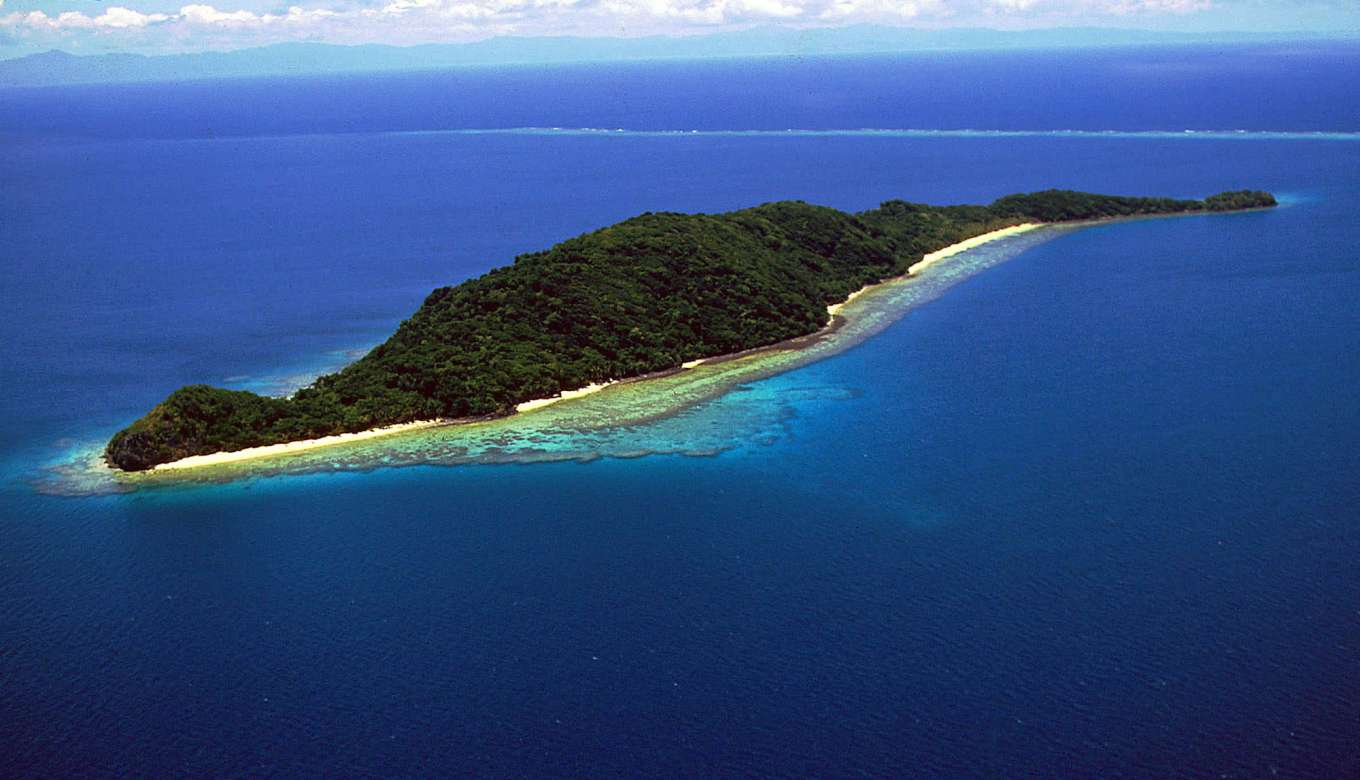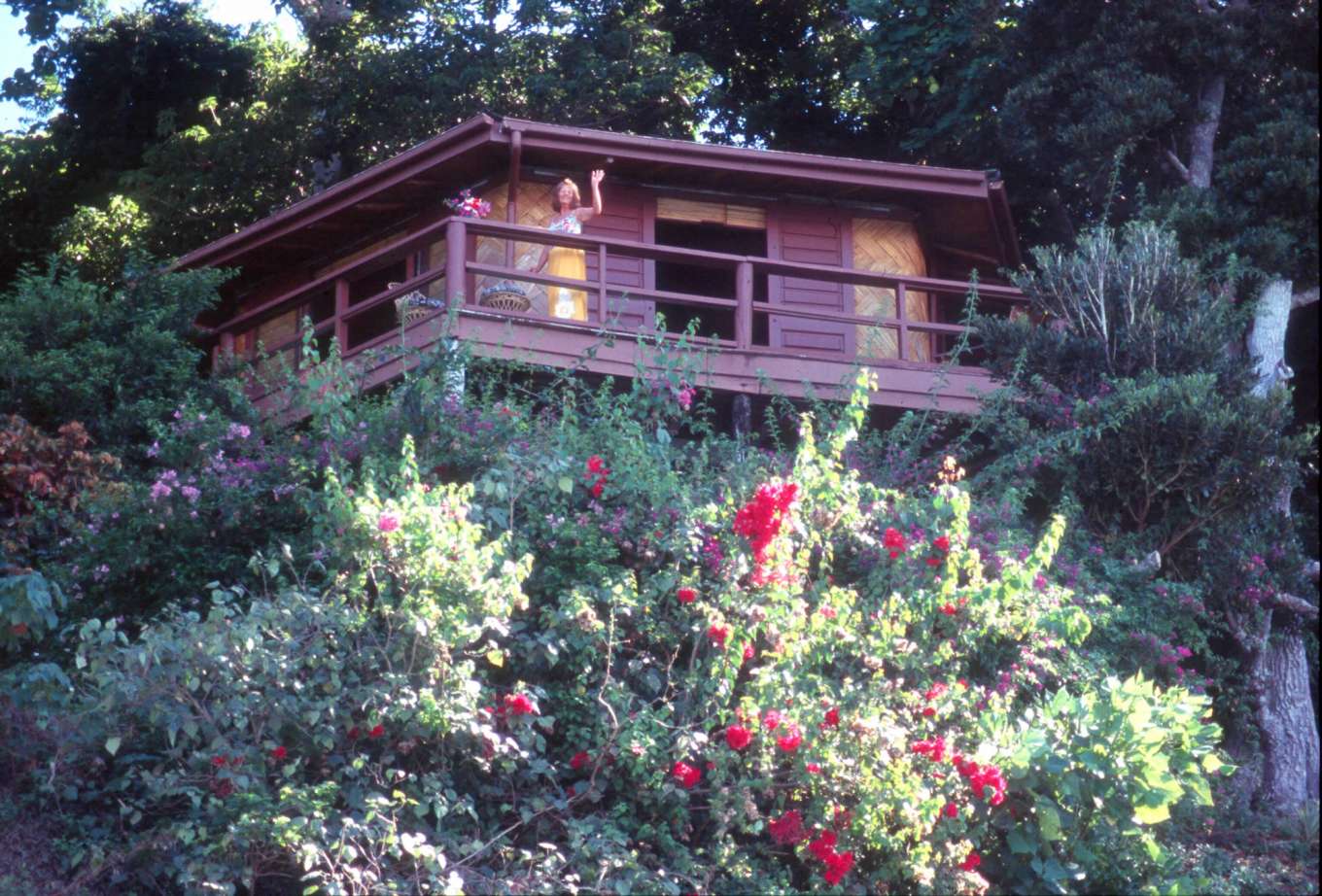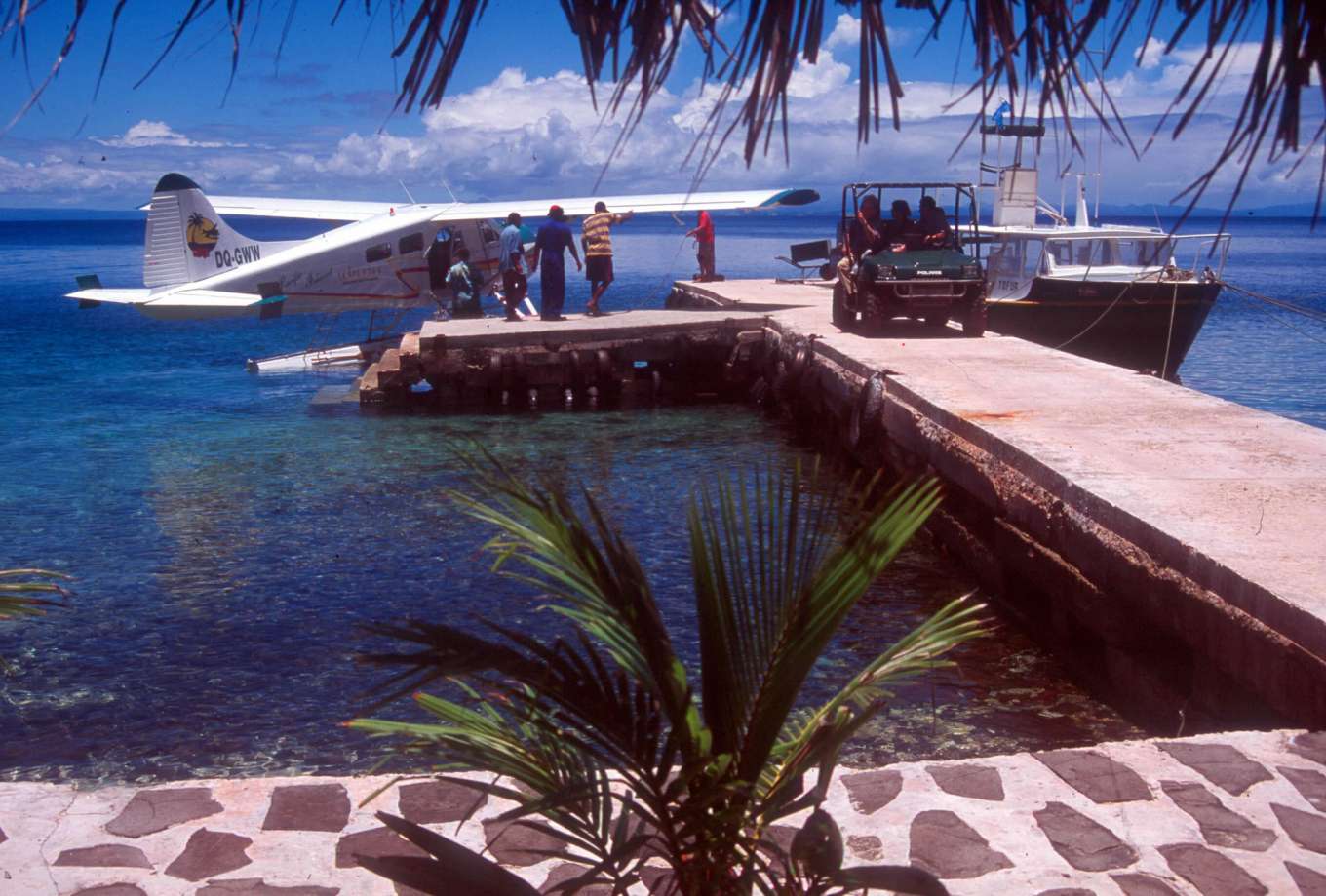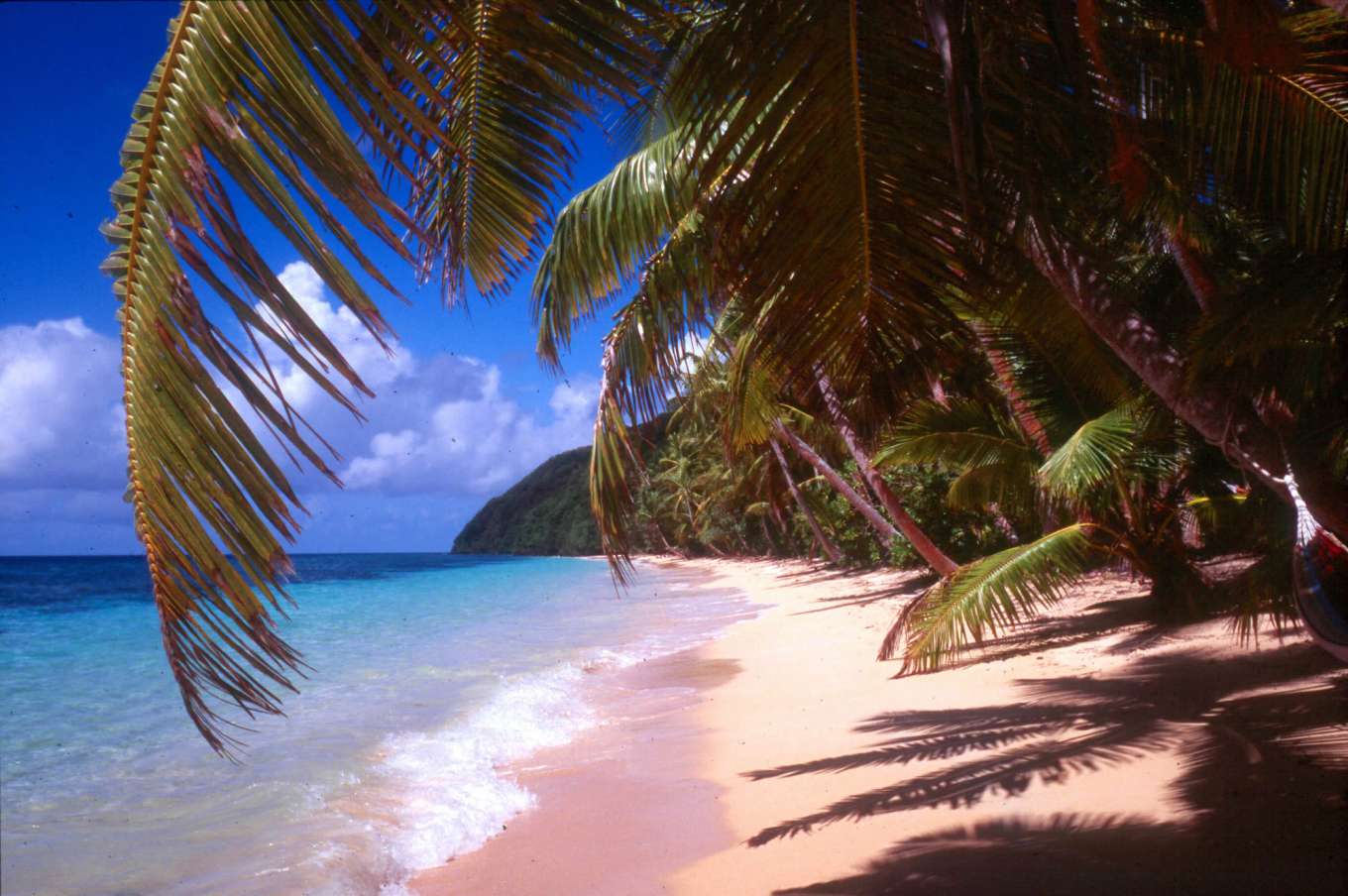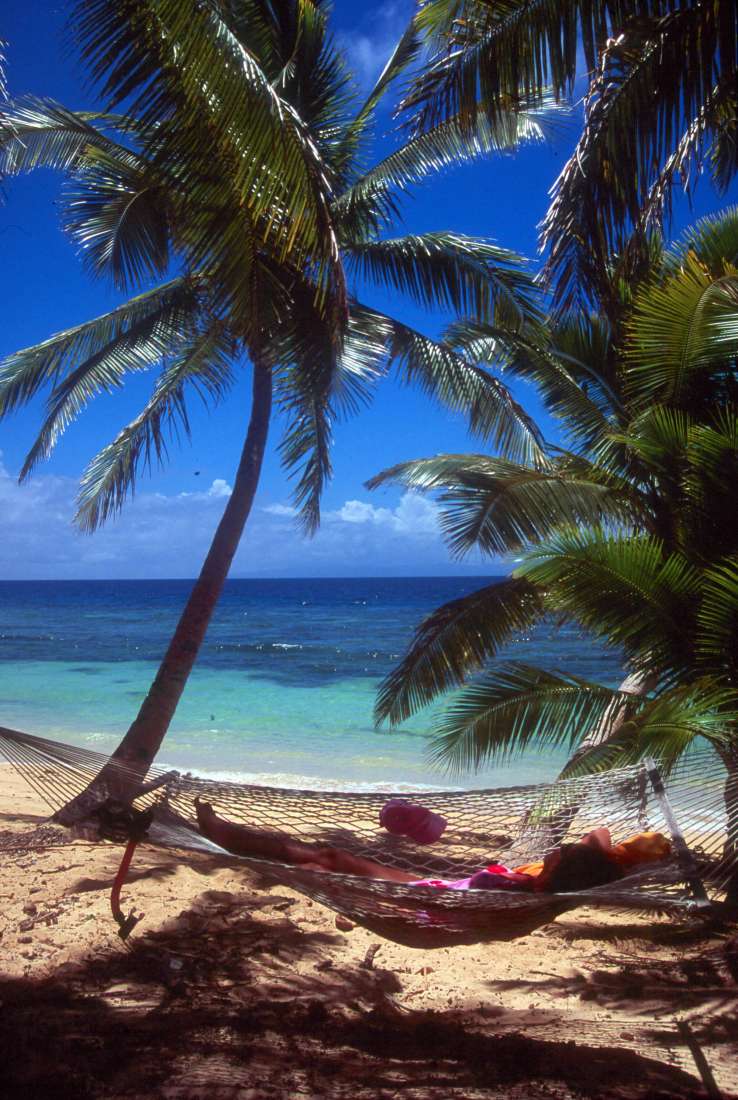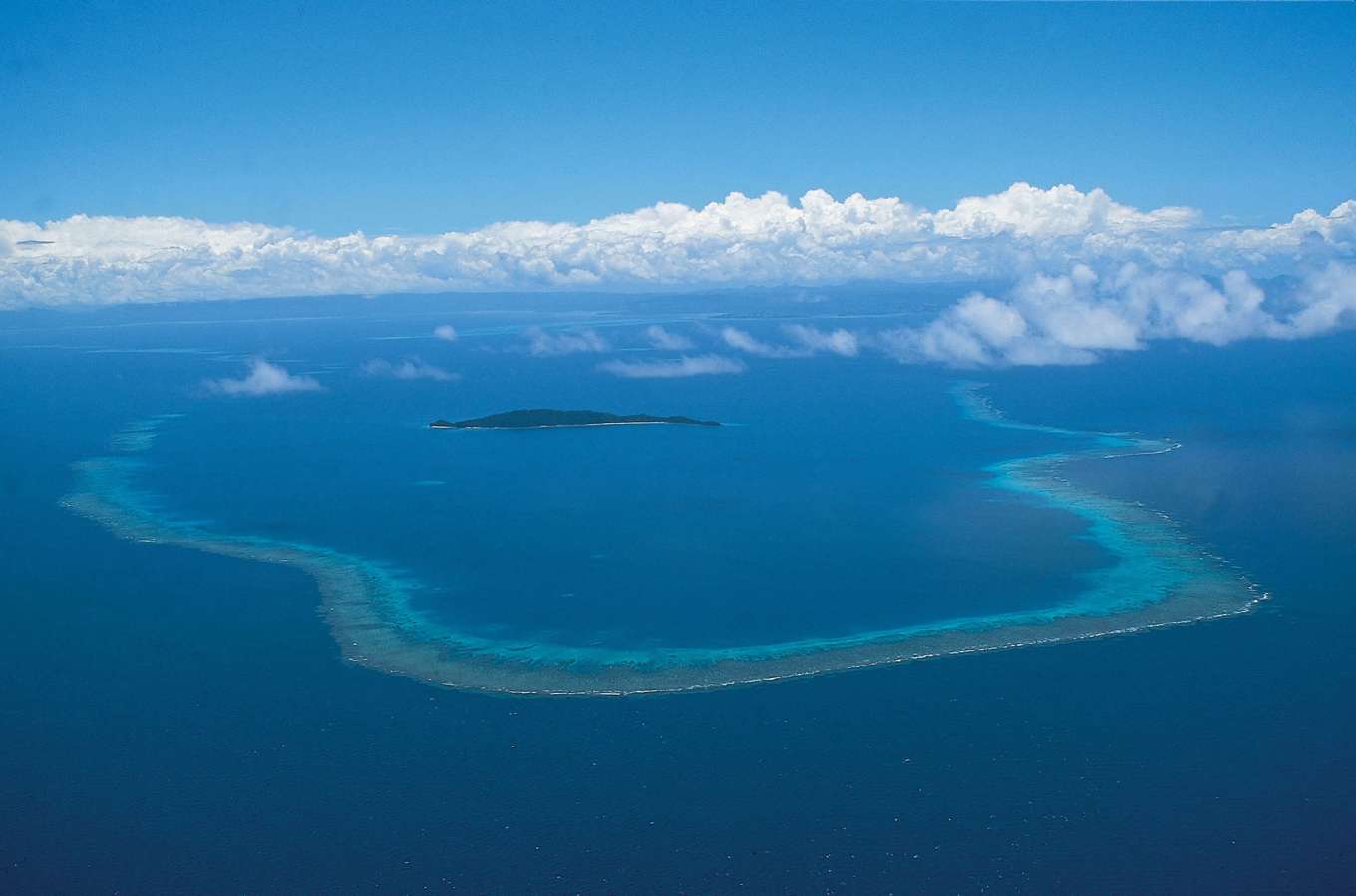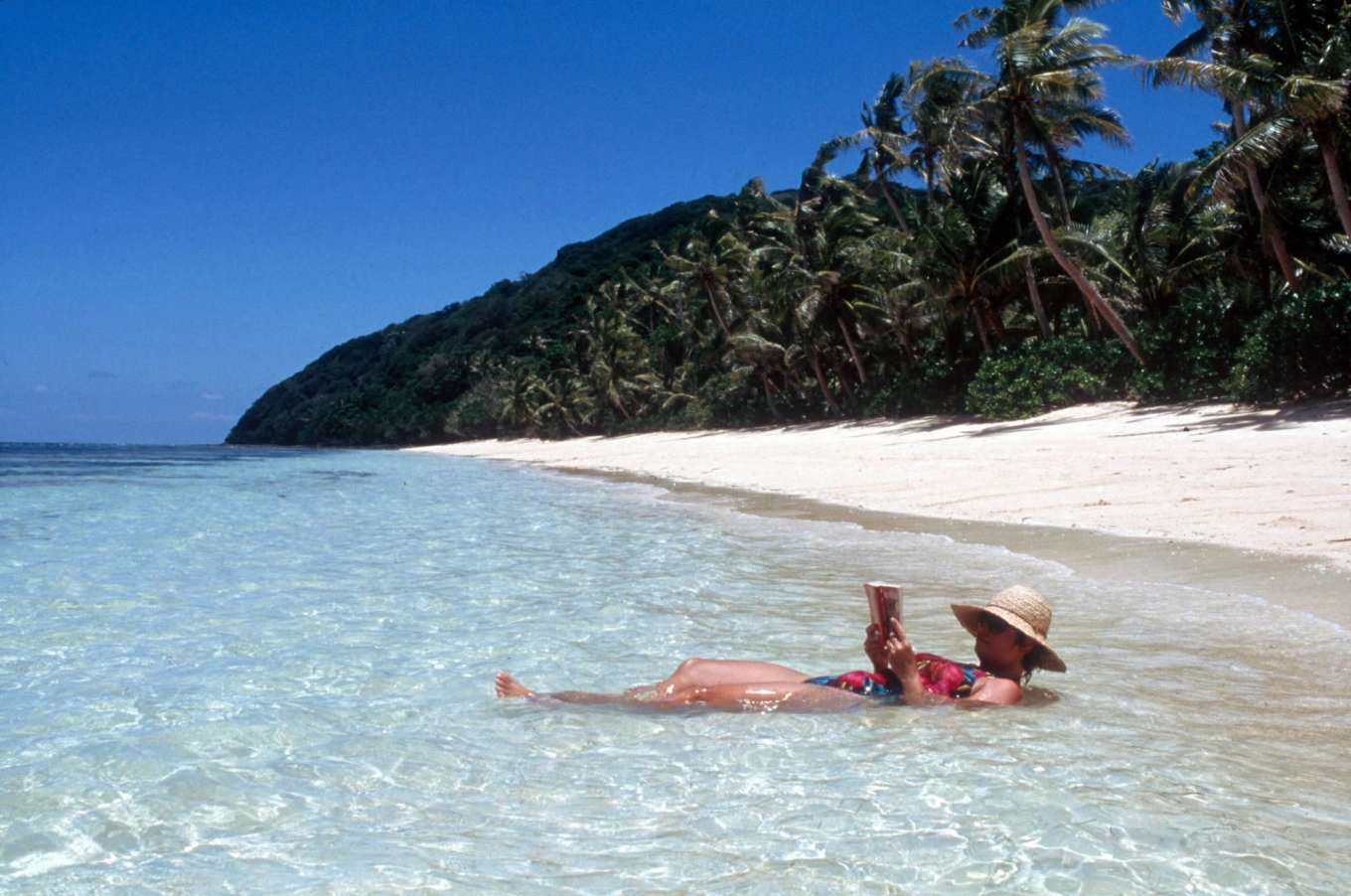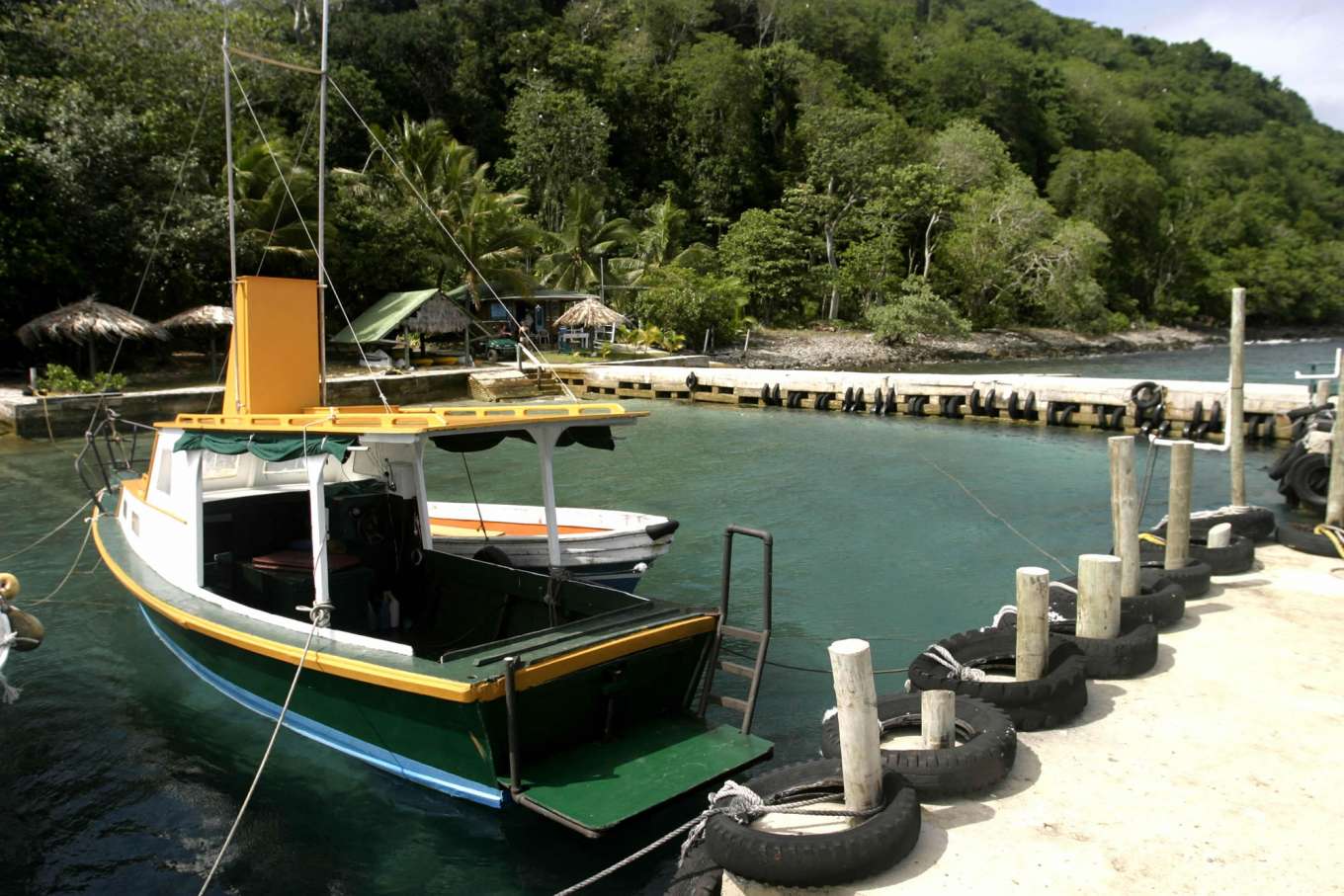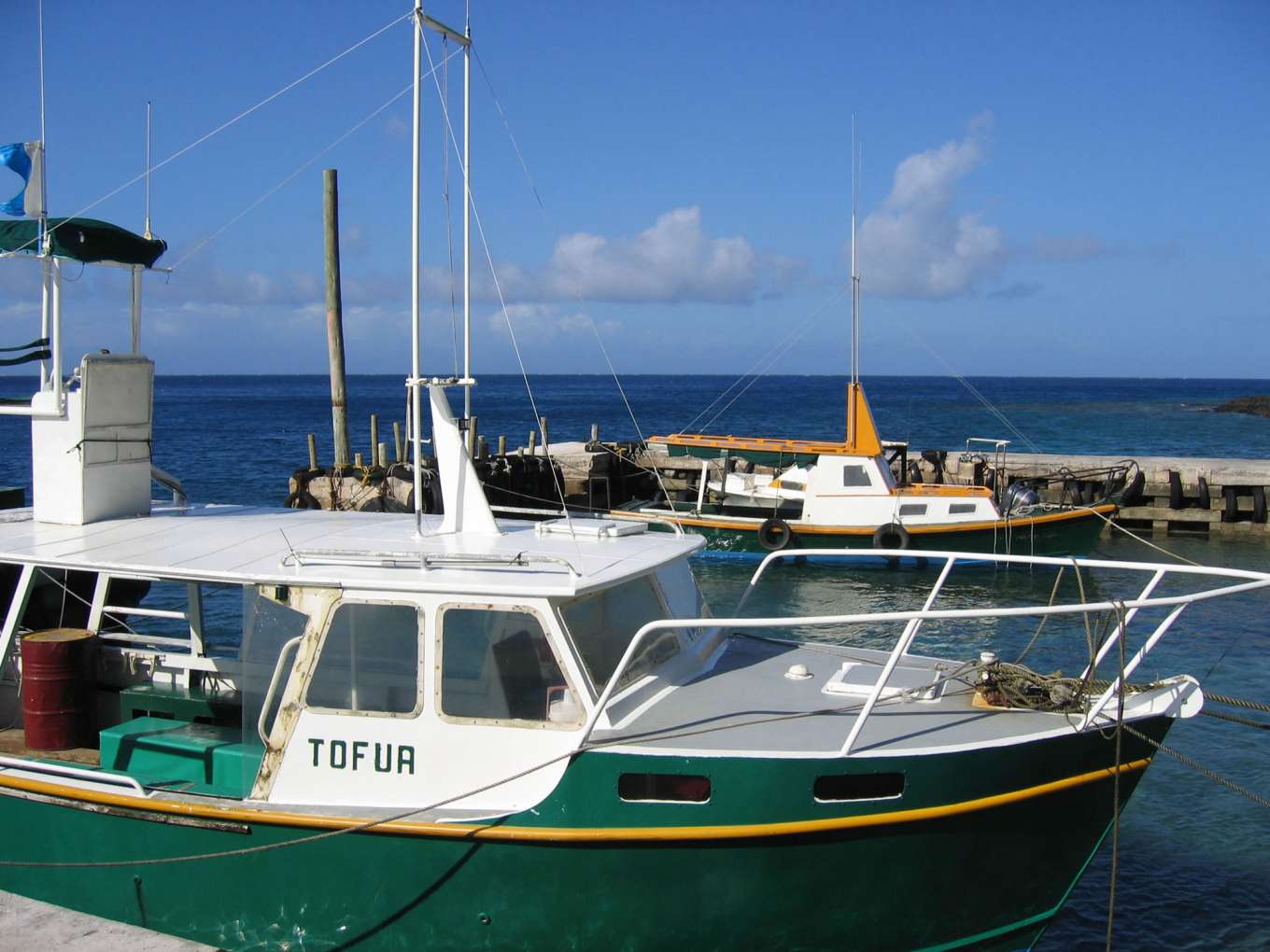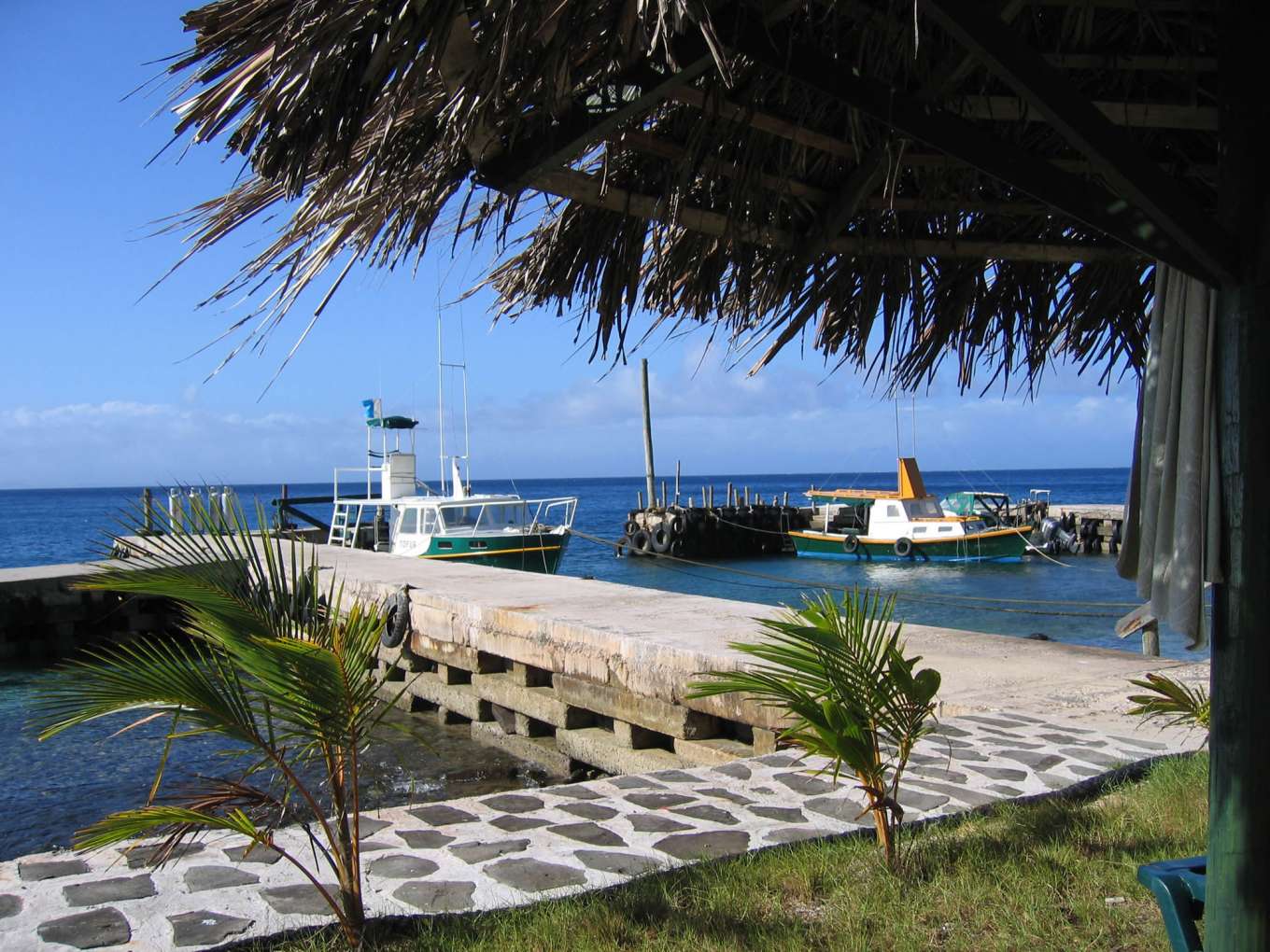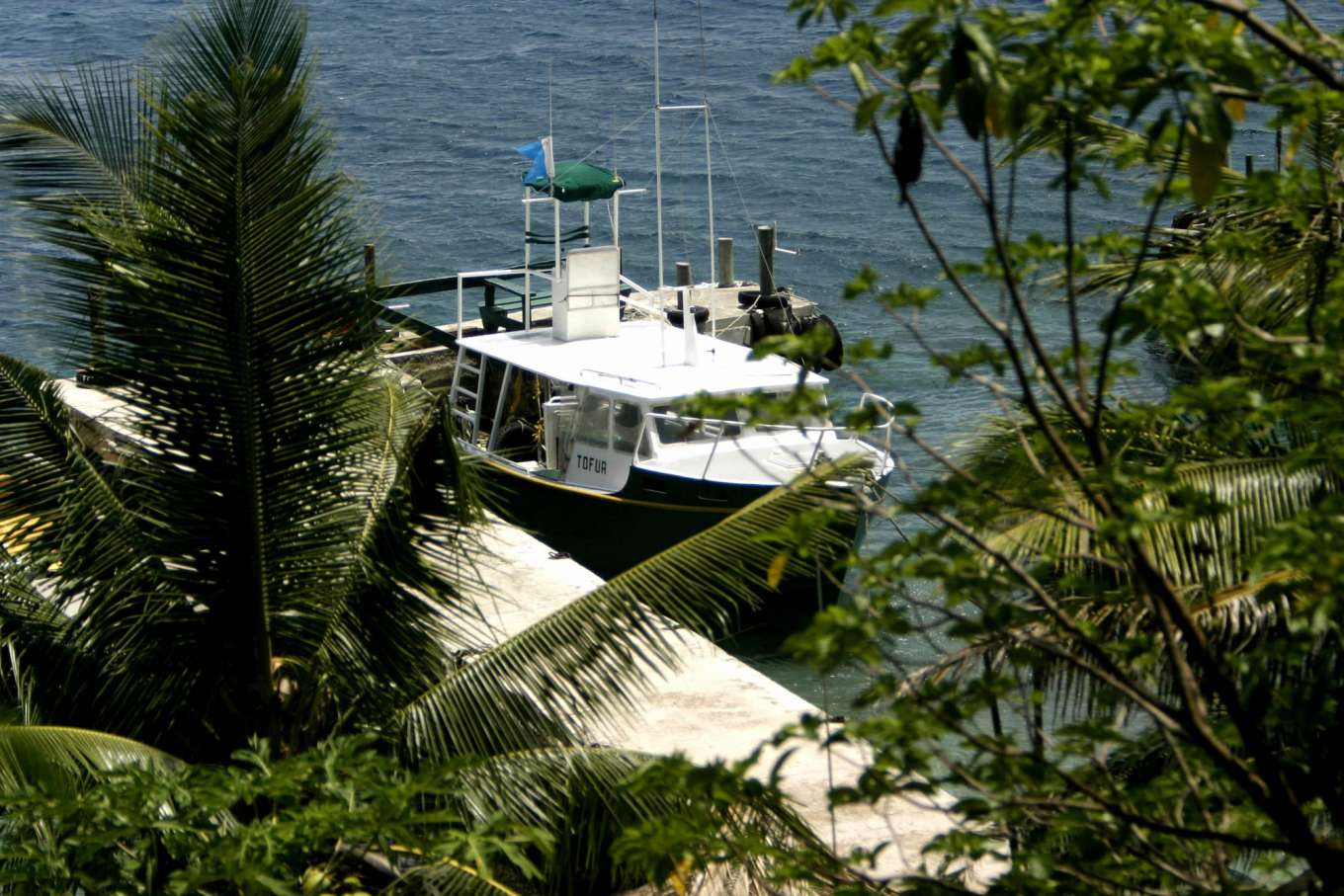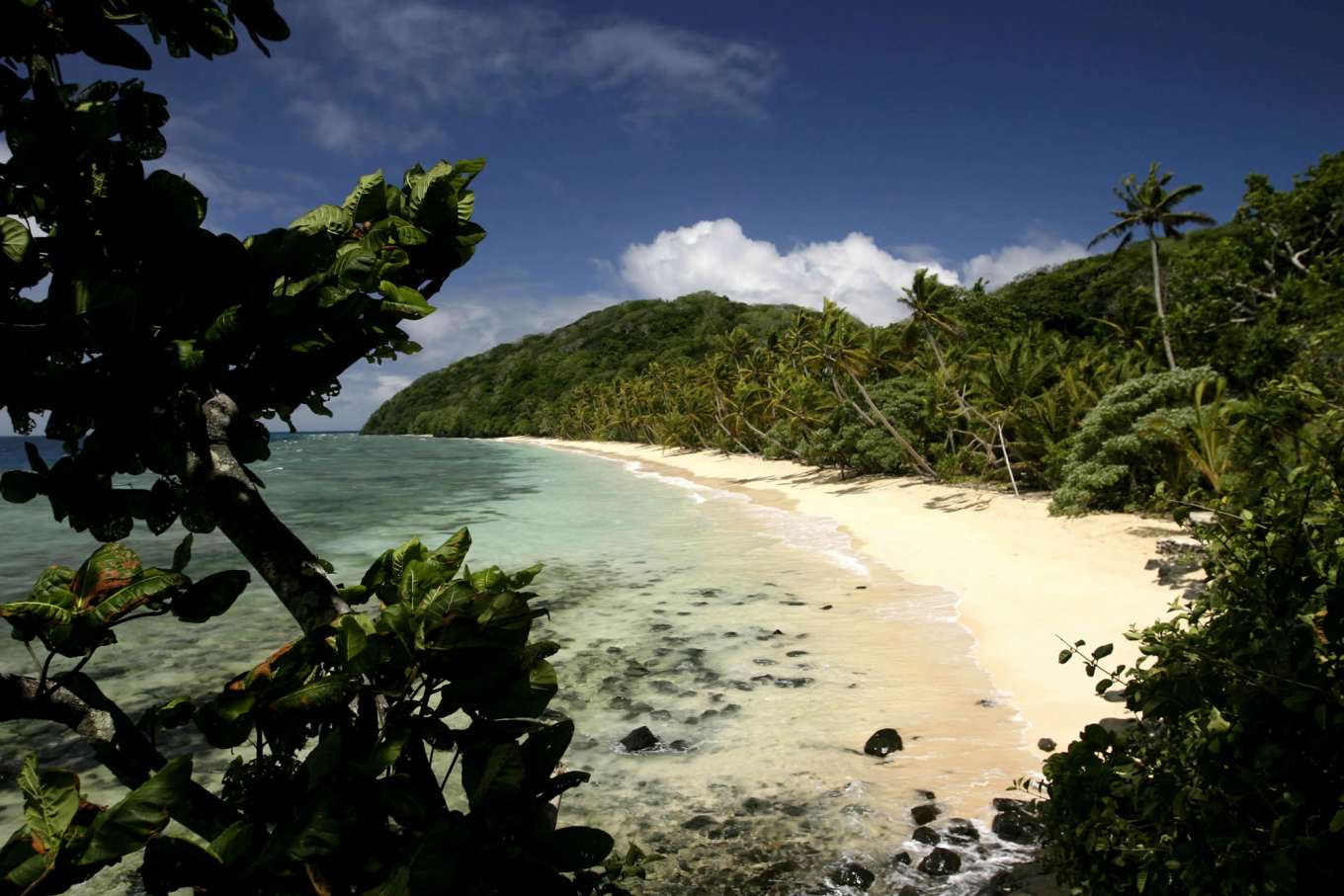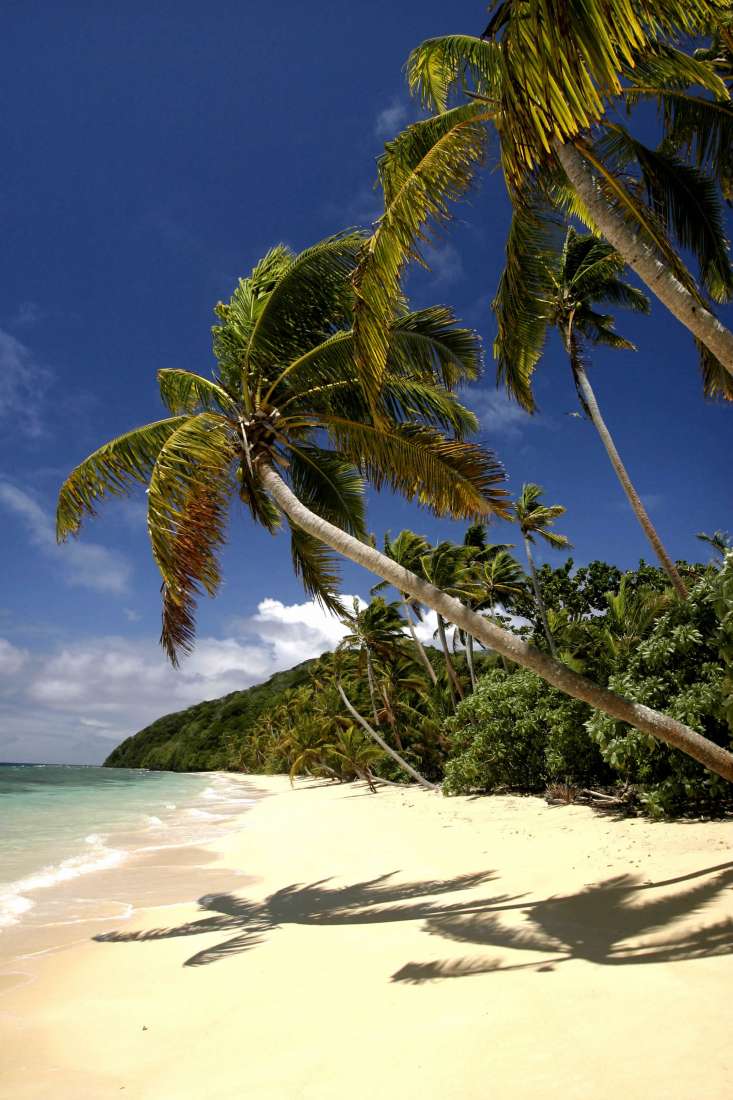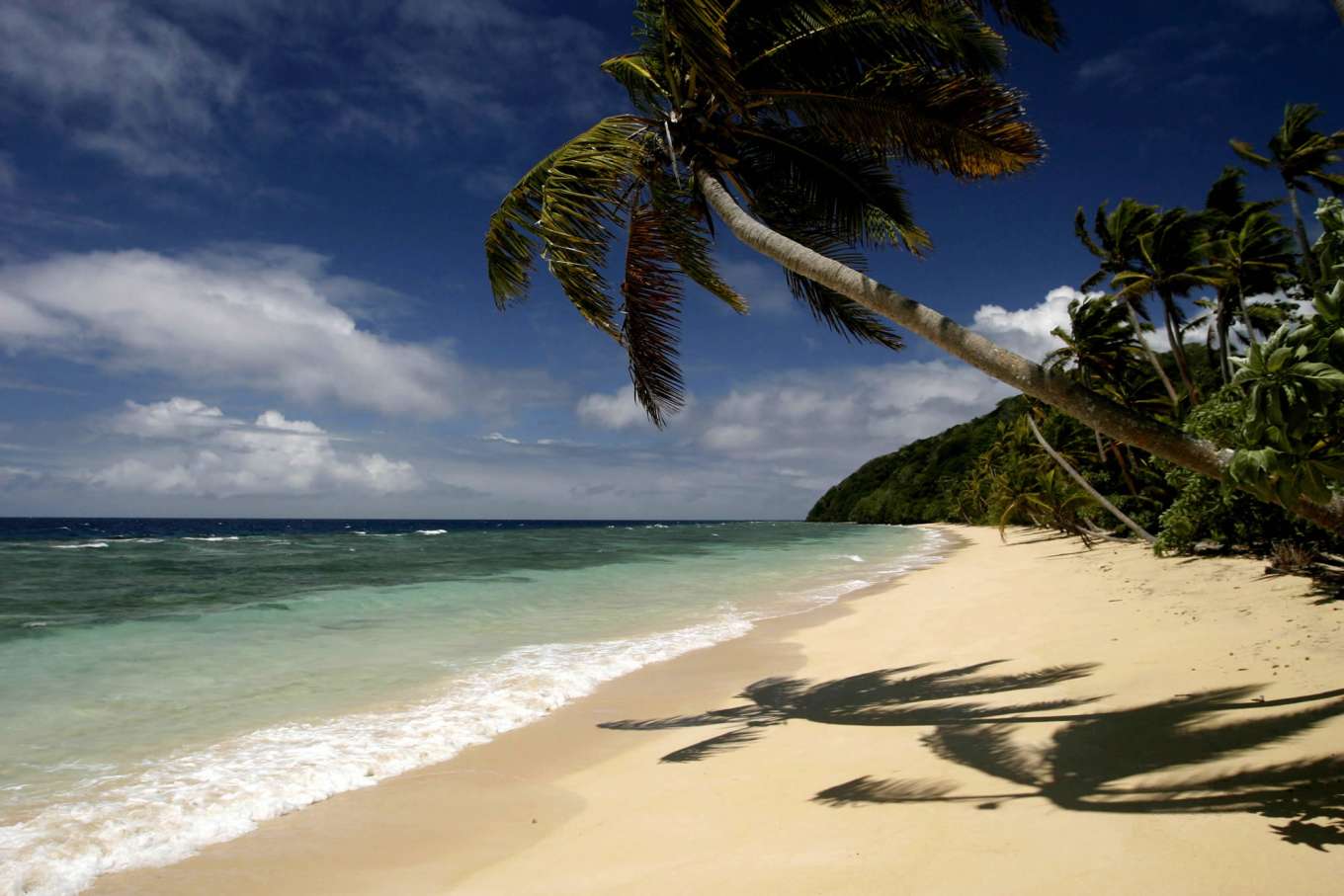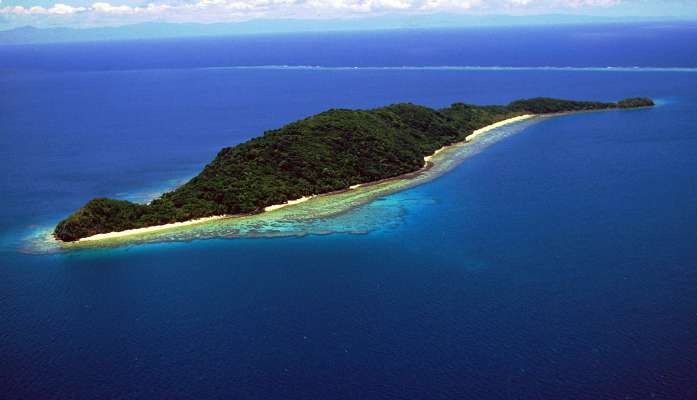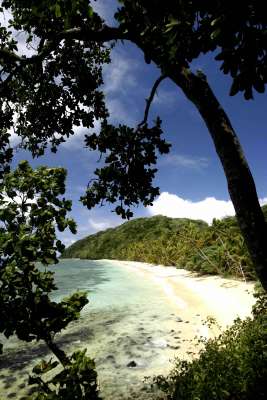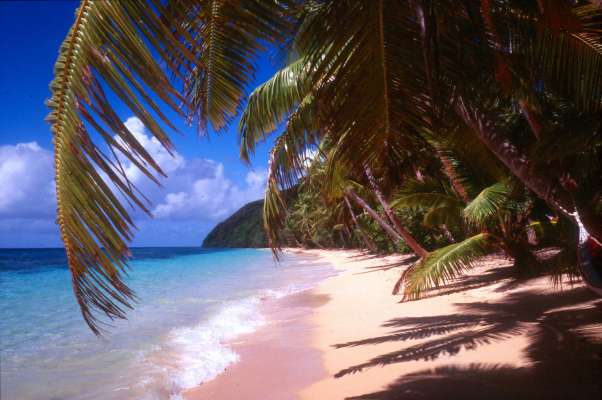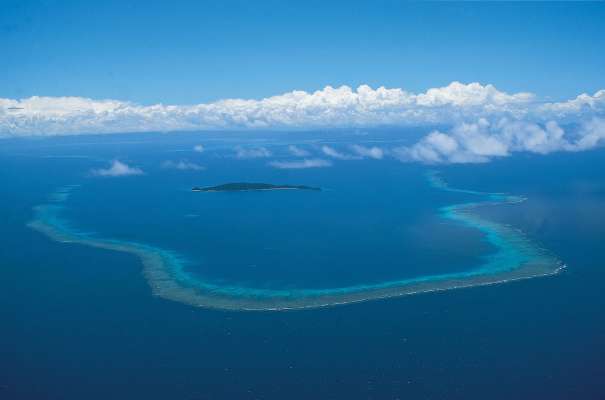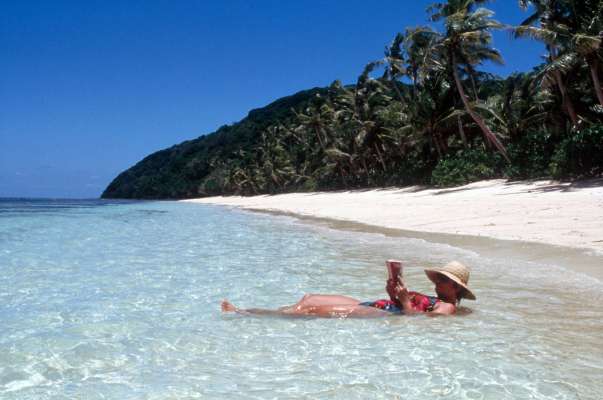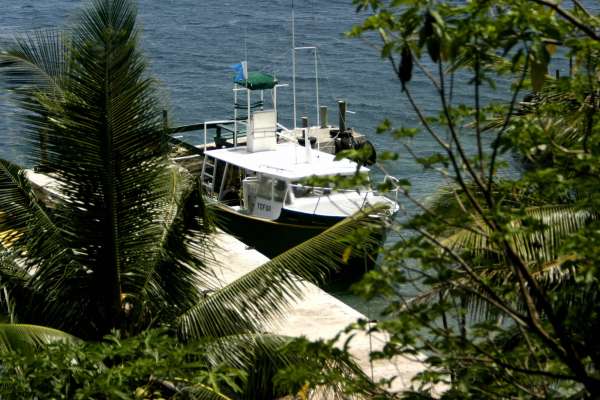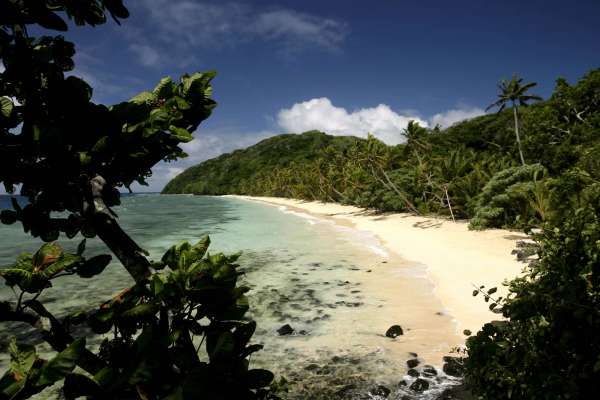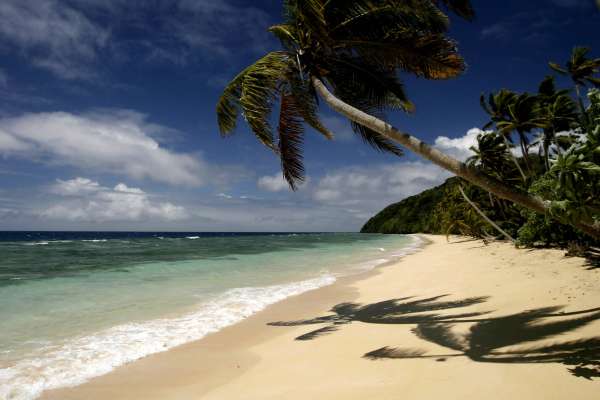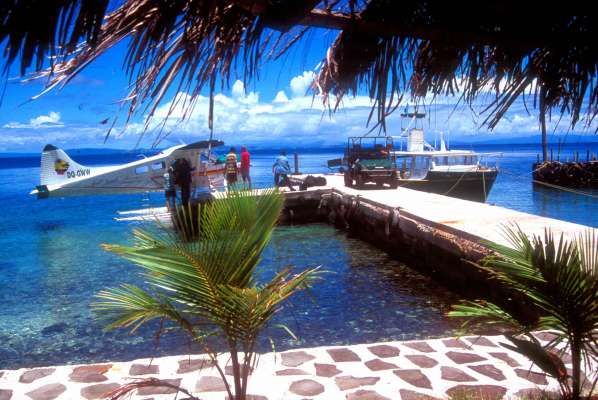Moody's Namena
MOODY'S NAMENA RESORT, FIJI is an environmentally friendly private island South Pacific getaway. Moody's offers scuba diving, snorkelling, fishing or honeymoon vacations with Fijian bure accommodation. The resort is a secluded paradise with white sand beaches as well as hiking trails through tropical forest.
Rising dramatically from the depths of the Koro Sea and on the fringe of Bligh Waters, lies the mile-long 110 acre island of N ...
MOODY'S NAMENA RESORT, FIJI is an environmentally friendly private island South Pacific getaway. Moody's offers scuba diving, snorkelling, fishing or honeymoon vacations with Fijian bure accommodation. The resort is a secluded paradise with white sand beaches as well as hiking trails through tropical forest.
Rising dramatically from the depths of the Koro Sea and on the fringe of Bligh Waters, lies the mile-long 110 acre island of Namenalala. It's surrounded by one of Fiji's most pristine diving and snorkelling reef ecosystems known as the Namena Barrier Reef.
The dragon-shaped island, with several powder-soft white sand beaches, is home to a six bures. The resort is owned and operated by Tom and Joan Moody.
Unlike most island resorts, where the bures, restaurant, bar & activity center is situated 'on the beach' to make the most of spectacular vistas of reefs, beaches and distant islands, we decided to locate on a cliff top where one has panoramic views and catches the trade winds as well.
The various bure sites were chosen carefully and spaced hundreds of yards apart to provide the ultimate in privacy.
Namenalala Island was uninhabited when Tom 'discovered' it in 1983 after camping on the island for two weeks. He decided that he would take one 10 acre portion to build the resort, leaving the majority of the island as he found it.
Walking trails are carved across the tropical forest, leading one to remote beaches where a picnic lunch can be sent upon request. At the highest elevation - around 400 feet - he found rock ruins of an ancient civilization and samples of pottery found were sent off and analyzed to be 2000+ years old.
Fiji's reef eco-system (often called the soft coral capital of the South Pacific) is diversified and the Namena Barrier Reef surrounding Namenalala Island is acclaimed by diving publications as one of Fiji's best sites.
Bird-watching is a popular pastime and there's a nature reserve with a red-footed booby nesting colony and a flying fox camp. Lesser frigates circle lazily at soaring heights, swooping down on the red-footed boobys to steal their dinner. The elegant long-tail tropic bird nests in the rocky cliffsides and in hollow tree trunks. Multi-hued land birds entertain you with their songs. Giant sea turtles come ashore to nest.
If communing with nature without giving up creature comforts is your idea of escape from a stressful hectic lifestyle, then "BULA" - it means welcome in Fijian.
The Resort
Our resort bures are hexagonal and built of native woods, bamboo and cane to blend with the environment. As each bure is perched along the ridge, all are oceanfront and each has its own unique view out to sea, overlooking either the beach or the reefs at the base of the cliffs. Four of the six bures face northwesterly towards the southern coast of Vanua Levu. 'Lawendua' is named after the elegant long-tailed tropicbirds which nest in crevices of the cliff-face below the bure. Several walls have floor-to-ceiling sliding louvered doors. By fully opening the doors, one has a 180 degree view out to sea. Various tropical bushes, plants and fruit trees lend color and provide privacy between each bure.
One of the six sections of the hexagon is the bathroom area with his/her toilets & sinks joined by an over-size shower. The bedroom is dominated by a king-size canopy bed with mosquito netting draped around the base of the canopy. You'll find coffee/tea making facilities in the beautiful hardwood cabinet tucked in a corner of your bedroom. Romantic gas lamps, reminiscent of lighting at the turn of the century, provide 24 hour lighting. There are solar lamps for reading in bed along with a fan for our hot humid summers when the tradewinds are light. Piped-in gas runs your lights, hot water for showers and your tea kettle.
The other bures along the north ridge are Bougainvillea, Hibiscus, and Mango. On the south side of the ridge, Nautilus Bure is at the cliff top and views from here are of the distant islands of Koro and Makogai and our own Nautilus Beach below.
Vandra bure, named for the beautiful vandra trees growing at its base, is on the beach and has its own special views of swaying palm trees, the sea and the white powder-soft beach we named Nautilus for the unusual deep-water shell which makes its way to the shore after sea storms.
The large hexagonal bure, 'vale ni kana' - or clubhouse, is our central gathering place. It consists of lounge area, dining, self-serve bar and houses a large paperback library. Here you will find books on fish and coral identification, birds, local culture & traditions. Dining is usually communal, a time to share the day's experiences with fellow guests. However, for our romantics or honeymoon couples who prefer to dine alone, our staff are happy to set up a table on the patio. Meals are included in the daily tariff and wine is complimentary with dinner. Our kitchen staff bake breads, pastries, cakes daily. They can also cater to your dietary requirements.
Although Namenalala Island doesn't have ground water or get the same annual rainfall at other places in Fiji, we grow our own bananas, pineapples, lemons/limes, papaya, soursop, sugar apples, heart of palm, coconuts and other tropical fruits and vegetables. Some are seasonal and may not be available year round but we can purchase them from the markets in Savusavu or Nadi.
Our cuisine is a blend of local and international fare and staff are happy to share or swap recipes.
The focus on Namenalala Island is enjoyment of the natural land and sea environment. The Namena Barrier Reef surrounding us is one of Fiji's most diversified and spectacular reef ecosystems with over 30 kilometres of walls and bommies (sea mounts).
In June 2004, the waters within the vast Namena Barrier Reef were declared a marine reserve with all commercial fishing was banned to permit fish stocks to breed and become as abundant as they were 20 years ago, prior to commercial fishing ventures. Although we still must run out poachers, as does every nation across the world, we are seeing a fast recovery in variety and numbers of all sorts of marine life which, in turn, encourages a healthy reef ecosystem. The South Pacific claims over 300 varieties of corals in comparison to around 30 varieties in the Caribbean seas. The Fiji Islands are known as the Soft Coral capital of the Pacific and the various colours and hues boggle the mind. Snorkellers have the same advantage as divers when it comes to enjoying the underwater world, except snorkellers can't remain below the surface as long as our scuba diving companions.
This ecosystem is one of the most diverse in the Fiji Islands with sheer drop-offs, a mile deep at the entrance to the North Save-a-Tack Passage, named Grand Canyon. Adjacent to that site is Fish Patch and Kansas. The latter is reminiscent of the golden wheat fields of the state of Kansas, USA. On the opposite passage of South Save-a-Tack you will find mostly bommies (seamounts) with names like Chimneys, Magic Mountain, Pirates Den, Tetons, Neptunes Haunt, Seven Dwarfs, Black Forrest and lots more. Between South Save-a-Tack around to North Save-a-Tack, there are many wall dives: Rainbow Wall, Unmarked Passage, Manta Mount, Cascades, the Finger-tip and more. A couple of the more-exposed sites south of Namenalala Island (at bottom of the photo above) are not always accessible during our winter months of July and August. The Pirate's Den has swim-throughs - sort of half-caves.
Depending on prevailing sea conditions, snorkellers are invited to join the scuba divers on the Namena Barrier Reef at no additional charge. There are reefs along the shoreline which are excellent for snorkellers year round. We do two excursions a day; a boat departs the dock at 9 a.m. for the morning snorkel/dive returning around 11 a.m. Just in time for a short hike or to laze on the beach. Then a leisurely buffet lunch around noon and perhaps a short siesta before the afternoon boat departs the dock between 1:30-2:00 p.m., depending upon the dive site chosen by your divemaster. Most boat trips are a 10-15 minute journey from the dock to the dive/snorkel site; the Fingertip is between 20-30 minutes away, depending upon which excursion boat is being used. Tofua is a 33 foot cabin cruiser and our newest addition. Salt Shaker is a 28 foot launch with a 200 H.P. engine, so it takes half the time as Tofua getting to and from our dive sites.
There are no moorings in the Namena Marine Reserve. We do not ever drop an anchor but our trained boat crew will drop off the snorkellers and divers and drift along nearby for pick-ups whenever it suits each individual to get out of the water. We recommend divers carry a dive safety sausage. We do not teach diving; therefore, one must bring his/her dive certification card in order to dive with us.
The Namena Barrier Reef abounds with hundreds of varieties of reef fishes, nudibranchs, sea cucumbers (beche-de-mer), barracuda, sharks, trevally, clownfish, trigger fish, wrasse, an occasional manta, turtles and a multitude of other sea creatures. After your snorkel or scuba dive, make use of our vast library to identify the underwater creatures you have seen.
Although turtles live in our waters year round, there is more activity during the breeding, nesting and hatching season between November and March. Our most popular turtle is the hawksbill although we do have some green turtles. We had an unusual happening in mid-October 2005 when arriving guests witnessed a turtle nest hatching! The latest we've ever seen a nest hatch was one season in the mid 1990s when the winter weather arrived earlier than normal and a nest hatched in late July - the incubation period was much longer than 60 days. In October turtles from far away - like Samoa - arrive to breed. It has been documented via satellite tracking that it took 2 months for the turtles to make the journey between Samoa and Namena Island and other parts of Fiji.
Information:
Water temperatures range from 75/76 F. in July and August (Fiji's winter). The rest of the year averages around 80-82 F.
We recommend 3mm wetsuits (long leg/long sleeve) for winter months.
We recommend 2-3mm shorty wetsuits for summer months (November through February).
For snorkellers, we recommend stretchy lycra bodysuits - lightweight, easy to pack and good protection from the sun.
We do not permit 'reef-walking' as it destroys millions of minute creatures with every step. Even though the top of the reef may look dead, it really isn't. As this is now the Namena Marine Reserve, we ask everyone to help support the reserve by purchasing a beautiful plastic tag which depicts an underwater animal. The proceeds go to the native 'owners' of the waters within the reef as a reward for not fishing. The cost of the tag is nominal at
F$20.
Kayaks: You are welcome to use our kayaks at any time. The island is about a mile long and it takes between 2-3 hours to circumnavigate by kayak. Others spend the day kayaking from beach to beach, stopping to snorkel the areas. We send a picnic lunch to a designated area for the couple to pick up. Or, spend a morning or afternoon hiking to the Dragon's Head; one trail follows the ridge where at the highest point of the island - 400 feet - you will find the remains of an ancient ring fortification - relics of the migratory Lapita people who lived on the islands prior to the present-day Fijian peoples. Walk through virgin tropical forests and observe nesting red-footed boobys, and resident fruitbats hanging in their 'camp'. Watch the lesser frigates circling high above waiting for the boobys to come home with their dinner so they can attack and force the booby to drop the fish, catching it in midair! Make your way to the head of the 'dragon' and observe one of the most spectacular views far out to sea. Join the staff in a fun game of beach volleyball. There is also complimentary snorkel equipment so you can visit the clam beds off the docks or snorkel the shoreline. We also offer fishing - either handline or trolling. We do NOT permit spearfishing. If you feel 'lazy', crawl into one of the hammocks on the beach and take a snooze or read a book. We have a large paperback library of every type of novel you would like to read; from non-fiction to mystery, romance, action, and more.
MOODY'S NAMENA RESORT, FIJI is an environmentally friendly private island South Pacific getaway. Moody's offers scuba diving, snorkelling, fishing or honeymoon vacations with Fijian bure accommodation. The resort is a secluded paradise with white sand beaches as well as hiking trails through tropical forest.
Rising dramatically from the depths of the Koro Sea and on the fringe of Bligh Waters, lies the mile-long 110 acre island of Namenalala. It's surrounded by one of Fiji's most pristine diving and snorkelling reef ecosystems known as the Namena Barrier Reef.
The dragon-shaped island, with several powder-soft white sand beaches, is home to a six bures. The resort is owned and operated by Tom and Joan Moody.
Unlike most island resorts, where the bures, restaurant, bar & activity center is situated 'on the beach' to make the most of spectacular vistas of reefs, beaches and distant islands, we decided to locate on a cliff top where one has panoramic views and catches the trade winds as well.
The various bure sites were chosen carefully and spaced hundreds of yards apart to provide the ultimate in privacy.
Namenalala Island was uninhabited when Tom 'discovered' it in 1983 after camping on the island for two weeks. He decided that he would take one 10 acre portion to build the resort, leaving the majority of the island as he found it.
Walking trails are carved across the tropical forest, leading one to remote beaches where a picnic lunch can be sent upon request. At the highest elevation - around 400 feet - he found rock ruins of an ancient civilization and samples of pottery found were sent off and analyzed to be 2000+ years old.
Fiji's reef eco-system (often called the soft coral capital of the South Pacific) is diversified and the Namena Barrier Reef surrounding Namenalala Island is acclaimed by diving publications as one of Fiji's best sites.
Bird-watching is a popular pastime and there's a nature reserve with a red-footed booby nesting colony and a flying fox camp. Lesser frigates circle lazily at soaring heights, swooping down on the red-footed boobys to steal their dinner. The elegant long-tail tropic bird nests in the rocky cliffsides and in hollow tree trunks. Multi-hued land birds entertain you with their songs. Giant sea turtles come ashore to nest.
If communing with nature without giving up creature comforts is your idea of escape from a stressful hectic lifestyle, then "BULA" - it means welcome in Fijian.
The Resort
Our resort bures are hexagonal and built of native woods, bamboo and cane to blend with the environment. As each bure is perched along the ridge, all are oceanfront and each has its own unique view out to sea, overlooking either the beach or the reefs at the base of the cliffs. Four of the six bures face northwesterly towards the southern coast of Vanua Levu. 'Lawendua' is named after the elegant long-tailed tropicbirds which nest in crevices of the cliff-face below the bure. Several walls have floor-to-ceiling sliding louvered doors. By fully opening the doors, one has a 180 degree view out to sea. Various tropical bushes, plants and fruit trees lend color and provide privacy between each bure.
One of the six sections of the hexagon is the bathroom area with his/her toilets & sinks joined by an over-size shower. The bedroom is dominated by a king-size canopy bed with mosquito netting draped around the base of the canopy. You'll find coffee/tea making facilities in the beautiful hardwood cabinet tucked in a corner of your bedroom. Romantic gas lamps, reminiscent of lighting at the turn of the century, provide 24 hour lighting. There are solar lamps for reading in bed along with a fan for our hot humid summers when the tradewinds are light. Piped-in gas runs your lights, hot water for showers and your tea kettle.
The other bures along the north ridge are Bougainvillea, Hibiscus, and Mango. On the south side of the ridge, Nautilus Bure is at the cliff top and views from here are of the distant islands of Koro and Makogai and our own Nautilus Beach below.
Vandra bure, named for the beautiful vandra trees growing at its base, is on the beach and has its own special views of swaying palm trees, the sea and the white powder-soft beach we named Nautilus for the unusual deep-water shell which makes its way to the shore after sea storms.
The large hexagonal bure, 'vale ni kana' - or clubhouse, is our central gathering place. It consists of lounge area, dining, self-serve bar and houses a large paperback library. Here you will find books on fish and coral identification, birds, local culture & traditions. Dining is usually communal, a time to share the day's experiences with fellow guests. However, for our romantics or honeymoon couples who prefer to dine alone, our staff are happy to set up a table on the patio. Meals are included in the daily tariff and wine is complimentary with dinner. Our kitchen staff bake breads, pastries, cakes daily. They can also cater to your dietary requirements.
Although Namenalala Island doesn't have ground water or get the same annual rainfall at other places in Fiji, we grow our own bananas, pineapples, lemons/limes, papaya, soursop, sugar apples, heart of palm, coconuts and other tropical fruits and vegetables. Some are seasonal and may not be available year round but we can purchase them from the markets in Savusavu or Nadi.
Our cuisine is a blend of local and international fare and staff are happy to share or swap recipes.
The focus on Namenalala Island is enjoyment of the natural land and sea environment. The Namena Barrier Reef surrounding us is one of Fiji's most diversified and spectacular reef ecosystems with over 30 kilometres of walls and bommies (sea mounts).
In June 2004, the waters within the vast Namena Barrier Reef were declared a marine reserve with all commercial fishing was banned to permit fish stocks to breed and become as abundant as they were 20 years ago, prior to commercial fishing ventures. Although we still must run out poachers, as does every nation across the world, we are seeing a fast recovery in variety and numbers of all sorts of marine life which, in turn, encourages a healthy reef ecosystem. The South Pacific claims over 300 varieties of corals in comparison to around 30 varieties in the Caribbean seas. The Fiji Islands are known as the Soft Coral capital of the Pacific and the various colours and hues boggle the mind. Snorkellers have the same advantage as divers when it comes to enjoying the underwater world, except snorkellers can't remain below the surface as long as our scuba diving companions.
This ecosystem is one of the most diverse in the Fiji Islands with sheer drop-offs, a mile deep at the entrance to the North Save-a-Tack Passage, named Grand Canyon. Adjacent to that site is Fish Patch and Kansas. The latter is reminiscent of the golden wheat fields of the state of Kansas, USA. On the opposite passage of South Save-a-Tack you will find mostly bommies (seamounts) with names like Chimneys, Magic Mountain, Pirates Den, Tetons, Neptunes Haunt, Seven Dwarfs, Black Forrest and lots more. Between South Save-a-Tack around to North Save-a-Tack, there are many wall dives: Rainbow Wall, Unmarked Passage, Manta Mount, Cascades, the Finger-tip and more. A couple of the more-exposed sites south of Namenalala Island (at bottom of the photo above) are not always accessible during our winter months of July and August. The Pirate's Den has swim-throughs - sort of half-caves.
Depending on prevailing sea conditions, snorkellers are invited to join the scuba divers on the Namena Barrier Reef at no additional charge. There are reefs along the shoreline which are excellent for snorkellers year round. We do two excursions a day; a boat departs the dock at 9 a.m. for the morning snorkel/dive returning around 11 a.m. Just in time for a short hike or to laze on the beach. Then a leisurely buffet lunch around noon and perhaps a short siesta before the afternoon boat departs the dock between 1:30-2:00 p.m., depending upon the dive site chosen by your divemaster. Most boat trips are a 10-15 minute journey from the dock to the dive/snorkel site; the Fingertip is between 20-30 minutes away, depending upon which excursion boat is being used. Tofua is a 33 foot cabin cruiser and our newest addition. Salt Shaker is a 28 foot launch with a 200 H.P. engine, so it takes half the time as Tofua getting to and from our dive sites.
There are no moorings in the Namena Marine Reserve. We do not ever drop an anchor but our trained boat crew will drop off the snorkellers and divers and drift along nearby for pick-ups whenever it suits each individual to get out of the water. We recommend divers carry a dive safety sausage. We do not teach diving; therefore, one must bring his/her dive certification card in order to dive with us.
The Namena Barrier Reef abounds with hundreds of varieties of reef fishes, nudibranchs, sea cucumbers (beche-de-mer), barracuda, sharks, trevally, clownfish, trigger fish, wrasse, an occasional manta, turtles and a multitude of other sea creatures. After your snorkel or scuba dive, make use of our vast library to identify the underwater creatures you have seen.
Although turtles live in our waters year round, there is more activity during the breeding, nesting and hatching season between November and March. Our most popular turtle is the hawksbill although we do have some green turtles. We had an unusual happening in mid-October 2005 when arriving guests witnessed a turtle nest hatching! The latest we've ever seen a nest hatch was one season in the mid 1990s when the winter weather arrived earlier than normal and a nest hatched in late July - the incubation period was much longer than 60 days. In October turtles from far away - like Samoa - arrive to breed. It has been documented via satellite tracking that it took 2 months for the turtles to make the journey between Samoa and Namena Island and other parts of Fiji.
Information:
Water temperatures range from 75/76 F. in July and August (Fiji's winter). The rest of the year averages around 80-82 F.
We recommend 3mm wetsuits (long leg/long sleeve) for winter months.
We recommend 2-3mm shorty wetsuits for summer months (November through February).
For snorkellers, we recommend stretchy lycra bodysuits - lightweight, easy to pack and good protection from the sun.
We do not permit 'reef-walking' as it destroys millions of minute creatures with every step. Even though the top of the reef may look dead, it really isn't. As this is now the Namena Marine Reserve, we ask everyone to help support the reserve by purchasing a beautiful plastic tag which depicts an underwater animal. The proceeds go to the native 'owners' of the waters within the reef as a reward for not fishing. The cost of the tag is nominal at
F$20.
Kayaks: You are welcome to use our kayaks at any time. The island is about a mile long and it takes between 2-3 hours to circumnavigate by kayak. Others spend the day kayaking from beach to beach, stopping to snorkel the areas. We send a picnic lunch to a designated area for the couple to pick up. Or, spend a morning or afternoon hiking to the Dragon's Head; one trail follows the ridge where at the highest point of the island - 400 feet - you will find the remains of an ancient ring fortification - relics of the migratory Lapita people who lived on the islands prior to the present-day Fijian peoples. Walk through virgin tropical forests and observe nesting red-footed boobys, and resident fruitbats hanging in their 'camp'. Watch the lesser frigates circling high above waiting for the boobys to come home with their dinner so they can attack and force the booby to drop the fish, catching it in midair! Make your way to the head of the 'dragon' and observe one of the most spectacular views far out to sea. Join the staff in a fun game of beach volleyball. There is also complimentary snorkel equipment so you can visit the clam beds off the docks or snorkel the shoreline. We also offer fishing - either handline or trolling. We do NOT permit spearfishing. If you feel 'lazy', crawl into one of the hammocks on the beach and take a snooze or read a book. We have a large paperback library of every type of novel you would like to read; from non-fiction to mystery, romance, action, and more.

